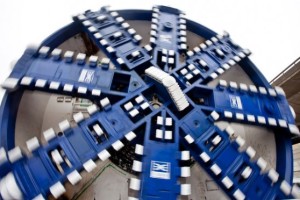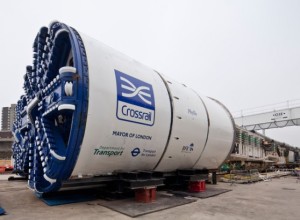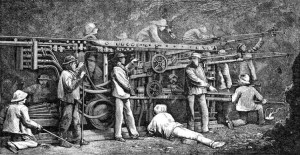How does a Tunnel Boring Machine Work
Tunnel-boring machines (TBMs) – sometimes known as ‘mega-moles’ within the industry – are pieces of drill-mining equipment used to excavate long tunnels, such as those used by cars and trains in hilly and mountainous regions. They can be configured to bore through a surprising variety of materials, ranging from sand, through to earth and even solid rock.
Each tunnel-boring machine consists of three key components: a cutterhead, hydraulic bracing system and an excavating conveyor, as well as a host of other elements.
The cutterhead comprises a circular metal face interspersed with discs that, when the cutterhead rotates – and it can turn a full 360 degrees – are forced against the tunnel face under immense pressure.
In this process the cutter discs roll over the surface, loosening the material – whether it’s rock or soil – into small segments referred to as chips. As the chips are created, they fall into large bucket lips, which are openings in the cutterhead that lead to a series of sheltered hoppers.
Once the hoppers receive the excavated material they discharge it onto a vast conveyor belt system that extends backwards through the central body of the tunnel-boring machine.
 At the rear of the TBM the belt deposits the material into a back-up area, which tends to be an enlarged cavern within the tunnel system with access to the surface. Here the chips are scooped up by a tracked or wheeled loading unit and placed into a ‘muck truck’, a large dump vehicle that specialises in traversing the tunnel system to the surface where the material can be dropped off for further processing or relocation.
At the rear of the TBM the belt deposits the material into a back-up area, which tends to be an enlarged cavern within the tunnel system with access to the surface. Here the chips are scooped up by a tracked or wheeled loading unit and placed into a ‘muck truck’, a large dump vehicle that specialises in traversing the tunnel system to the surface where the material can be dropped off for further processing or relocation.
Importantly, the overall extraction process greatly relies on a TBM’s ability to remain stable within the tunnel it is mining. This is made possible due to radially mounted hydraulic braces, which are fixed to the mega drill’s body, pushing outwards into the tunnel’s walls.
These braces simultaneously stabilise its position so it can push forward, while also supporting the structure of the tunnel. Once braced, a series of hydraulic cylinders extend from the TBM’s body and press the cutterhead’s disc cutters firmly against the tunnel face, allowing a new stretch to be cleared.
 While drill mining is, of course, the primary purpose of a TBM, it also acts as a platform for many of the safety procedures needed to secure a tunnel during the building process.
While drill mining is, of course, the primary purpose of a TBM, it also acts as a platform for many of the safety procedures needed to secure a tunnel during the building process.
These include installing rock anchors, metal meshes, steel beam supports and, at the rear of the TBM, the necessary pumps and nozzles required to inject shotcrete – a mortar/ concrete wet mix used to line and reinforce tunnel walls. All these tasks are performed in the ‘working area’ of the TBM, a large segment positioned just behind the cutterhead where ring erectors, anchoring drills and wire-mesh installers semi-automatically secure a freshly excavated tunnel to make it safe for tunnel workers to proceed.
Mining in action
Spraying platform
Any excavated tunnel needs to be continually reinforced structurally to prevent cave-ins. This is achieved by driving supportive steel bolts into the walls, lining them with metal meshes and covering the entire lining with a substance called shotcrete (a combination of mortar and concrete). The shotcrete is applied through a pump nozzle from a spraying platform.
![Mining wheel loader]() Mining wheel loader
Mining wheel loader
Similar to the wheel loaders used on the surface, though jacked up with improved hydraulic lifting arms, heavy-duty chassis frames, reinforced driver cabins and large engines, mining wheel loaders are designed to dig into, pick up and deposit vast quantities of excavated material into the muck trucks.
Mining muck truck
These are the ultimate dump trucks, capable of f\ carrying phenomenal loads of excavated material in their chip basins. Their immense carrying ability is granted by their insanely high-torque, high-horsepower engines, as well as industrial-grade truck frames optimised for torsion load displacement.
Tunnel borer
The most advanced pieces of drill-mining equipment, tunnel borers specialize in continuously excavating tunnel faces no matter what they’re made of. Various types are manufactured ranging in size, length and material expertise (eg sand, earth, rock, etc). The largest TBM in the world has a cutterhead 19.3m (63.3ft) across!
Shaft drill
These allow their operator to use a series of drill shafts/booms to penetrate tunnel faces with acute precision. The drills – which are akin to manual jackhammers – extend from the vehicle’s body on long hydraulic arms and, powered pneumatically, drive their drill bits into the rock/earth to break it up.
Boring history
 Prior to mechanised boring machines, tunnels were made through a mixture of explosives and manual labour, with men and machine alike locked in an incredibly dangerous game of knock and run.
Prior to mechanised boring machines, tunnels were made through a mixture of explosives and manual labour, with men and machine alike locked in an incredibly dangerous game of knock and run.
The introduction of the first boring machines didn’t improve things much either, with the early systems relying on water compressors to supply them with pressurised air to drive their drills into the earth.
The machines broke down frequently and, due to their cumbersome and inaccurate nature, led to many accidents deep within mountain excavations. Other early systems, such as the 1853 Wilson’s Patented Stone-Cutting Machine, just failed to work at all. Famously, engineer Charles Wilson’s contraption, which had been employed to help drill out the Hoosac railroad tunnel in Massachusetts, USA, cut through just three metres (9.9 feet) of rock before breaking and falling to bits.
The tunnel was eventually completed 20 years later using traditional methods and it, as well as the remains of Wilson’s machine, can still be seen there to this day.

